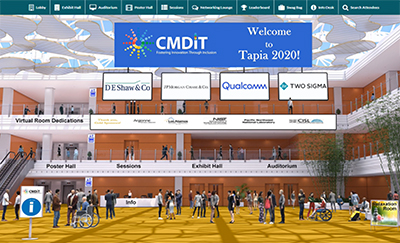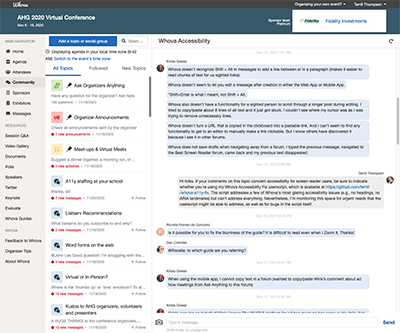Accessibility and Online Conferences
In the July 2020 edition of AccessComputing News, the article Accessibility and Third-Party Products and Services described the critical need to consider accessibility early when shopping for technology solutions, and recommended addressing accessibility at three stages of the procurement process: Soliciting accessibility information from vendors; validating the accessibility information received; and including accessibility assurances in contracts. Online conferencing platforms provide an excellent example of this need.
As most conferences have moved online since early 2020, they have turned to the use of a variety of technologies in an effort to replicate the functionality of face-to-face conferences. Conferences commonly feature presentations, an agenda or schedule of events, opportunities for networking and discussion among attendees, exhibitors demonstrating their products and services, and poster sessions.
Unfortunately, many of the platforms and tools used by conferences for providing these functions online do not currently meet accessibility standards and consequently are difficult, if not impossible, for people with disabilities to use. For example, screen reader users depend on properly coded page structure, with headings that form an outline of the page and particular page regions (e.g., banner, navigation, and main) explicitly identified in the underlying HTML code; users who are physically unable to use a mouse must be able to access all links, buttons, and controls with keyboard alone; and users who are unable to hear the presenters depend on captions and expect to have some control over how those captions are displayed. Most, if not all, online conference platforms fail in one or more of these areas.
In order for this situation to change, conference organizers must demand accessible products. The more vendors hear from their potential customers that accessibility is an important consideration – maybe even a deal-breaker – the more likely they will be to recognize the market demand for accessibility. This is a wide-open opportunity for any vendor that embraces accessibility, as they can be first to market with an accessible product.
Meanwhile, conference organizers, despite the lack of accessible choices for online conferencing platforms, still need to provide accessible conference experiences. They cannot simply discriminate against people with disabilities and provide conference features that are only available for non-disabled attendees. This requires working proactively with their chosen vendor as early as possible in the negotiation process, to try to help them recognize the implications of their accessibility failures and commit to fixing them. Whenever possible, accessibility expectations including a timeline for fixing known issues should be included in the contract. It also requires thinking creatively about workarounds, in case vendors fail to deliver an accessible solution on time.
The following case studies describe how two conferences, both of which have long histories as face-to-face events, went fully online in fall 2020, and responded creatively to the need for an accessible conference solution.
Case Study 1: Richard Tapia Celebration of Diversity in Computing Conference
The Tapia Conference is an annual fall conference that seeks to acknowledge, promote, and celebrate diversity in computing. AccessComputing had representation on the Infrastructure Committee for the 2020 conference. Tapia chose vFairs as its online conferencing platform. vFairs provides a virtual experience that visually resembles a face-to-face conference, including an on-screen replica of an interactive lobby, exhibit hall, and auditorium. The virtual conference spaces even include virtual attendees mingling and browsing, and Tapia worked with vFairs to ensure those attendees had diverse characteristics, including people with visible disabilities such as wheelchair users and people using white canes.

Although visually compelling, vFairs had major problems with accessibility for attendees who are blind or visually impaired, as well as other attendees who use assistive technologies or custom configurations. AccessComputing staff, on behalf of Tapia, conducted an accessibility review of the platform and met with vFairs representatives on two occasions to discuss the most significant problems and describe possible solutions. The parties shared an online document in which progress was tracked on each of these issues. vFairs made some progress, and was able to fix a few of its problems, but ultimately, they ran out of time so many of the accessibility fixes were "in progress" but not deployed in time for the conference.
As a workaround for the accessibility issues, Tapia provided attendees with a guide to navigating the conference environment with a screen reader. This guide included key landmarks and workarounds for navigating through the otherwise inaccessible features of the conference platform.
After the conference, vFairs representatives agreed to meet with a panel of conference attendees who have disabilities (three screen reader users and one attendee who uses eye-gaze technology in combination with Dragon speech-to-text software). The attendees described the challenges they faced in navigating and using the software, which helped to reinforce to vFairs that the work they had started would benefit actual users, and accessibility was not just an abstract technical specification.
Case Study 2: Accessing Higher Ground
Accessing Higher Ground (AHG) is an annual fall conference focused on accessible media, web and technology in higher education. AccessComputing had representation on the Program Committee for the 2020 conference. AHG actively sought recommendations for an accessible conferencing platform, but as noted above, all available products seem to fall short on accessibility, so AHG chose Whova, despite its known accessibility problems.
AccessComputing staff, on behalf of AHG, conducted an accessibility review of the platform and provided a report to the vendor that included code-level recommendations for solutions to the most significant problems. At Whova's request, a meeting was set up to ensure they understood the report, and these issues were then handed off to the engineering team. However, they were unwilling to commit to fixing their accessibility problems in time for the conference, nor were they willing to offer a timeline by which the problems might be addressed.

Since AHG is a conference about accessibility, and since many of the attendees are known to have disabilities, AHG especially needed a workaround. Their solution was to develop a userscript, a JavaScript file that runs in a browser extension such as Greasemonkey or Tampermonkey, and fixes many of Whova's accessibility problems client-side, after Whova has loaded in the browser. This was created by AccessComputing staff as an open source project called Whova Accessibility Fix, hosted on GitHub. Conference attendees, particularly those who use screen readers, spoke fondly of this solution. As one attendee said in an email, "I can use the Whova desktop app without issue. Thanks to you and your sweet JavaScript band aid."
With more time to promote this effort, this could potentially be an effective means of building community around accessibility. Anyone who has JavaScript skills and/or web accessibility skills could participate in developing the solution in collaboration with others as part of a team, and could learn new skills as part of the effort.
However, despite its positive side, this solution has its drawbacks. It's essentially a hack, based on a snapshot in time of the application it's seeking to fix. If the company rolls out any changes, this could very easily break the solution, and since the solution is created independently of the company, there is no communication between the parties. Also, this solution may provide vendors with a false sense of relief from responsibility to fix their accessibility bugs. It's already difficult to persuade vendors to fix accessibility of their products. They may be even less motivated to do so if they believe their customers can use a fallback solution to avoid discriminating against their participants.
Logistical Considerations
In addition to choosing – to the extent possible – an accessible online conferencing platform, conference organizers can take many other steps to ensure their conferences are accessible. For example:
- Provide a means on the conference registration form for attendees or presenters to request accommodations.
- Be prepared to provide accommodations when they're requested, such as live captions or sign language interpreters. Identify vendors who provide these services and be prepared to use them. It is important to make arrangements early, to understand the steps for enabling these services in the chosen conference platform, and to relay that information to anyone who needs it (hosts, moderators, presenters and/or attendees). In 2020, demand for captioning has increased dramatically, so skilled captioners are in short supply, which means making arrangements early is especially important. Also, note that conference participants who need captioning and interpreting will need these accommodations for all parts of the conference, not just for presentations (e.g., for interacting with exhibitors and for networking events).
- Provide live captions and sign language interpreters proactively for large events such as keynotes, plenaries, and featured sessions.
- Provide information to speakers about how to ensure their presentations (e.g., PowerPoints and digital handouts in Word or PDF) are fully accessible, with alt text for images, proper heading structure in handouts, and adequate color contrast.
- If the conference includes pre-recorded videos of presentations, be sure to caption all videos.
- Another common accommodation request is access to presentations and slideshows. Again, proactively collecting presentations and sharing them with attendees can ensure everyone has access.